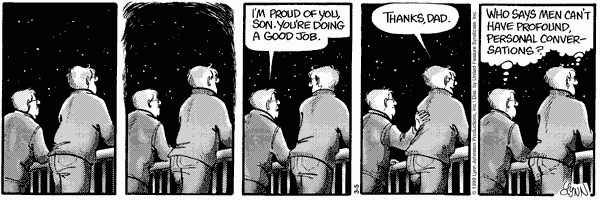I have a five frame comic strip, “For Better For Worse” taped on the shelf over my desk. The first frame of the comic show a father and his adult son leaning on a porch railing, at night, looking thoughtfully at the stars. In the second frame the dad says, “I’m proud of you son. You’re doing a good job” In the third frame the son replies, “Thanks, Dad.” In the last frame both of them have a thought bubble over their head with the same thought, “Who says men can’t have profound, personal conversations.”
That little comic strip, like much of the communication by men, said a whole lot to me with just a few words. Men don’t talk as much to express feelings as they talk to share information. Truthfully, a lot of our communication doesn’t just mean talking.
Not long ago a man on hospice service was being transferred from his home to the hospice’s inpatient facility for end of life care, meaning he was going there to die. At the patient’s home, as they were preparing to place the patient into the ambulance to transfer him, his son asked if they could stop by him and his dad’s favorite lake to go fishing. The hospice nurse, Tammy, immediately agreed. She instinctively knew that the purpose was not to go fishing one last time. Tammy knew that this would be the way for the son to say thank you to his dad for all of the happy memories, and to say, “I love you.”
When I was going through my training to be a hospice volunteer, I went through a communication class. Some of the important aspects of communicating that we discussed in that class were to be opened minded when dealing with people (don’t prejudge), to listen (not just wait my turn to talk) and to observe their mannerisms and body language. Seems strange, but talking was not discussed in that class nearly as much as the prejudging, body language and listening.
As an example of non-judgmental, non-verbal communication, a family that I was involved with a few years ago comes to mind. The assignment was that of a man roughly my age. Clearly, he was too young to be in this situation. He had oral cancer and consequently could not talk.
My first visit was on a dreary, cold, Good Friday evening. I am always apprehensive on my first visit because I don’t know what to expect as to the patient’s personality, the family dynamics, the type and condition of the living quarters, etc. Since I am entering another family’s inner sanctum I must be accepting of their way of living. At this stage I make a conscious effort to be completely open minded. If I’m not, any of my body language or facial expressions may signal disapproval. Non-verbal communication plays an even larger role in our lives that verbal communication.
The apartment that I was entering is where this man had lived for years and it was in this apartment that he chose to complete his life. His room was filled with display cases of swords, daggers, battle-axes and various other types of weapons. Many more similar items were mounted on the walls. Even the man on service was covered with tattoos of daggers and swords. His hair was combed back in the classic duck-tail style of the 1950’s. My first impression was that he must’ve been a “pretty tough customer” at one time.
As mentioned, he could not speak so during this first visit I learned in a hurry how he conveyed when he needed his mouth moistened or the TV channel changed. About a half an hour into the visit his 9 year old granddaughter arrived, she was a “spittin image” of the girl who played the middle daughter on the 80’s sitcom, “Full House”. This little girl had the same hair style, same voice, and the same looks as the character Stephanie.
After her arrival she took off her coat then come over to her Grandpa’s bedside. She pulled over a chair, stood up on it, gently raised his head off the pillow, and brushed his hair. She pulled down his blanket and sheet then brought them back up and tucked them under his chin.
Next she moistened his lips with a toothette (a small sponge on a stick), wiped his face with a warm wash cloth, changed the TV channel to his favorite show and finally sat down on the chair next to his bed. She tenderly put her hand through the bed railing placing it on the mattress near his waist.
I thought the patient had been asleep because his eyes had been closed and he was passive through all of her activity. He slowly moved his hand off his abdomen and onto her hand. As their fingers entwined, I felt a tear form. I was profoundly touched by what I had just witnessed. After a minute, she looked at me and said, “This is how he tells me that he loves me.”
Sometimes there are no words to express what is being felt. What I witnessed was love in its purest form. She communicated love to him without saying a word, and he as well. One half hour earlier I had entered a somewhat dingy apartment filled with the acrid smell of stale cigarette smoke. I had entered the room of a gruff appearing patient. It was a room that was filled with articles of violence. In very short order, in a very quiet way, I had learned about love, tenderness, and communication.
It’s easy to get wrapped up in the surface drama of a situation and overlook the silent connection of the eyes or the tender affection of two hands touching. This little girl taught me that to truly communicate all you need is a hand to hold and a heart to understand. I haven’t had a hospice family yet who hasn’t taught me in some little way that communicating doesn’t just mean talking.
Author Rick Schneider












